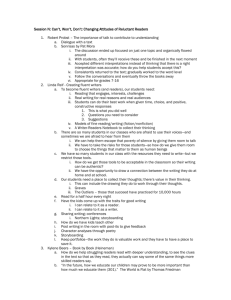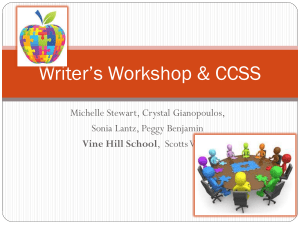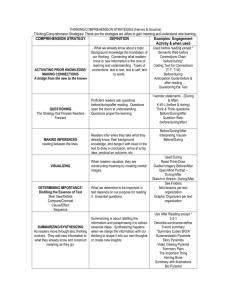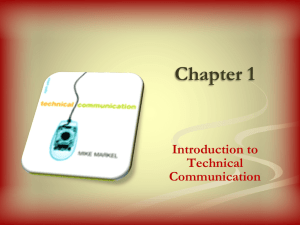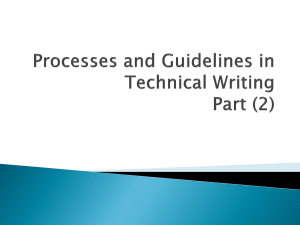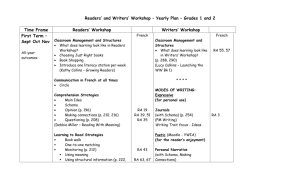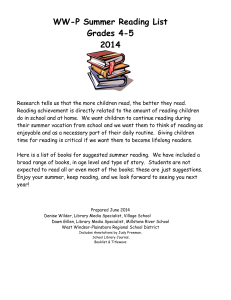File
advertisement
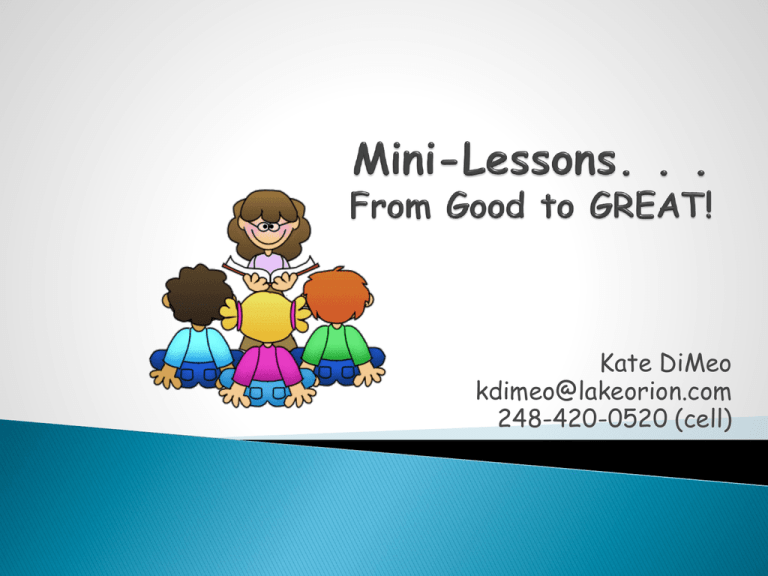
Kate DiMeo kdimeo@lakeorion.com 248-420-0520 (cell) (55 minutes total) Mini-Lesson (10-15 minutes) Independent Practice (20-30 minutes) Mid-workshop Interruption (1-2 minutes) Partnership (5-10 minutes/2x a week) Share (5 minutes) Spelling it only takes 15 minutes a week (3 minutes a day) . . Booktalks they only take 7 minutes a day (3minutes per kid) . . . Grammar paper it only takes 25 minutes a week . . .(5 measly minutes a day) Journal writing (only 5 minutes a day) . . . Read a loud only 10 minutes a day . . . . Cold read and hot read fluency passages . . .15 minutes a week, 5 minutes a day Writing in the planner . .3 minutes a day Checking last nights homework . . 3 minutes a day Office interuptions (or colleague) . . .3 minutes a day or 10 minutes a week All this adds up to 44 minutes . . .or more than a day of independent reading Connection Teaching Active Engagement Link Put today’s work in the context of children’s on going work and explicitly name what will be taught today. Last night I was looking at my notes about your writing/reading and . . . or Yesterday we learning that readers. . .today we are going to build on that or Many of you are doing _____in your reading so today we are going to explore_____ If you are referring to yesterday’s work just refer to yesterday, don’t repeat that last several days lessons. Avoid hand-raising. Make it sticky by adding an object . . .a tangible touchable something. Use metaphors in your connection phase! It’s the stories that pull kids in. Change your tone and sense of urgency. Use a video clip. “Good teaching is one-fourth preparation and threefourths theater.”- Gail Godwin Choose a lesson. Readers ask themselves what is the heart of this story before, during and after reading. Readers group together words when reading. Readers pause and ponder as they read. Brainstorm a connection. A personal story or metaphor or tangible object. We name ONE new tool or concept that we hope they will use often as they read. Today I am going to teach you . . . . what+how Repeat! Repeat! Repeat! Demonstration. . .step by step, talking as you go Guided Practice . . .hand it out, let them give it a try and coach (all mini-lessons have a little of this with active engagement) but when it is the 2nd or the 3rd lesson on the same thing NOT the first time they have ever done it Inquiry . . . so effective but takes so long, save it for read aloud with accountable talk • Mini lessons do NOT results in assignments • Mentor texts are referred to and used as examples but not read out loud in their entirety during the mini-lesson, chapter excerpts are sometimes used during but tred carefully • SLOW DOWN . . .go blow by blow like you are telling a story • Use movement. Gestures cement memory. • The metaphor or story is not the teaching. The assignment is not the teaching. • Role plays or fish bowls are “safe” and effective. Watch me as I show you . . .Today I am going to teach you . . Notice how I . . . • Head caution . .writing on your chart is not teaching, in fact this should take no more than 5% of your total mini lesson time (to be continued . . .) • Just an example or two, don’t overwhelm students by getting them lost in all the examples. • Make it concrete, if you are going to talk about a book you’ve read, hold it up. If you are going to read from a book, have the book. • Push yourself to state and restate the teaching point (and maybe even state again) in every lesson. Try to use the same wording each time. Watch me as I show you . . .Today I am going to teach you . . Notice how I . . . Visual Representations are a Critical Piece of the Teaching Component! Charts must be made memorable and referred to often! Pictures, photos, catchphrases all help children hold onto the teaching. To be continued . . . . We set children up to briefly use the strategy or concept we’ve tried to teach them scaffolding the work so that it is in their zone of proximal development. TO WITH BY If you’ve taught the lesson well—you should see the results here. Overhead/Digital Version/Enlarged Text or Video Clip (Why not there own copy?) Teacher gives students a book (with caution, 90% accessible) Provide copies of a page of the text (read it aloud if needed) Students bring their just right books (really hard) Sticky Notes or Dry erase boards Turn and Talk (e.g. EEKK, assigned spots) Stop and Jot (e.g. Stickies, Dry Erase Boards, Notebooks) Stop and visualize Act Out Keep track of the steps I take . . Air Write Keep asking yourself . .Am I asking kids to do what I just did? Don’t write the responses on chart paper. Don’t have the kids tell you what they were discussing, eaves drop and share on their behalf. If you call on a child to share as you wrap up active engagement be sure to have all students focus on that child, his words are as important as yours. If children report back to class after active engagement be sure it is just that and not a private conversation between you and the student or partnership. Make sure kids are doing exactly what you modeled Make sure directions are crystal clear and materials are easily distributed Steps . . .first, then, finally, make your teaching more explicit Assign turn and talk partner Collect Stop and Jots for group forming and quizzes* (If you are revisiting a lesson not teaching it for the first time) We restate our teaching point and encourage children to either apply this new learning to today’s work or add it to their repertoire of possibly strategies for future use. Generalize the lesson (i.e. So when you are writing/reading remember you can . . ) Watch out for the IDR task overload! The Art of Teaching Writing by Lucy Calkins (Chapter 12 pp. 193-219). The Nuts and Bolts of Teaching Writing from Calkins Units of Study K-2 (Chapter 5 pp. 45-59) A Guide to the Writing Workshop from Calkins Units of Study Gr. 3-5 pp. 54-68. A Quick Guide to Making Your Teaching Stick K-5 by Shanna Schwartz http://chartchums.wordpress.com Smarter Charts k-2 by Marjorie Martinelli and Kristi Miraz Growing Readers by Kathy Collins pg. 23-28 A Guide to the Reading Workshop from Calkins Units of Study Gr. 3-5 pp. 47-58.
